Update: Andrés Jiménez Zorrilla (CEO of SWP) has provided some additional information in the comments. In particular:
- SWP is looking to raise over $1m for this effort, to deploy additional stunners and add a dedicated staff member
- SWP's goal with this project is for it to severe as a catalyst to industry-wide adoption
- While SWP's estimate of animals impacted includes only 50-75% at each producer, the pilot would likely be extended to cover 100% if successful
Summary
- The Shrimp Welfare Project (SWP) has a novel opportunity to spend up to $115,500 to purchase and install electric stunners at multiple shrimp farms
- The stunners would be used to stun shrimp prior to slaughter, likely rendering them unconscious and thereby preventing suffering that is currently experienced when shrimp asphyxiate or freeze without effective analgesics
- Based on formal agreements SWP has signed with multiple producers, raising $115,500 would enable the stunning (rather than rather than conventional slaughtering) of 1.7 billion shrimp over the next three years, for a ratio of nearly 15000 shrimp/dollar
- I performed a preliminary cost-effectiveness analysis of this initiative, looking at direct impacts only (i.e. not considering the potential for this project to catalyze industry-wide change). I reached the following three tentative conclusions:
- The expected cost-effectiveness distribution for electric shrimp stunning likely overlaps that of corporate hen welfare campaigns
- The cost-effectiveness of electric shrimp stunning is more likely to be lower than that of corporate hen welfare campaigns than it is to be higher
- Shrimp stunning is a very heavy-tailed intervention. The mean cost-effectiveness of stunning is significantly influenced by a few extreme cases, which mostly represent instances in which the undiluted experience model of welfare turns out to be correct
- Given these results, electric shrimp stunning might be worth supporting as a somewhat speculative bet in the animal welfare space. Considerations that might drive donor decisions on this project include risk tolerance, credence in the undiluted experience model of welfare, and views about the likelihood of this project accelerating more widespread adoption of humane shrimp slaughter practices.
Description of the Opportunity
The following information is quoted from the project description written by Marcus Abramovitch on the Manifund donation platform, based on information provided by Andrés Jiménez Zorrilla (CEO of SWP) :
Project summary
Shrimp Welfare Project is an organization of people who believe that shrimps are capable of suffering and deserve our moral consideration [1]. We aim to cost-effectively reduce the suffering of billions of shrimps and envision a world where shrimps don't suffer needlessly.
- Programme: our current most impactful intervention is to place electrical stunners with producers ($60k/stunner): We have signed agreements with 2 producers willing and able to use electrical stunning technology as part of their slaughter process which will materially reduce the acute suffering at the last few minutes / hours of shrimps lives. Collectively, these 2 agreements will impact more than half a billion animals per year at a rate of more than 4,000 shrimps/dollar/annum. Please take a look at our blog post on the first agreement here.
- We are in advanced negotiations with 2 more producers which would take the number of animals to more than 1 billion shrimps per annum.
- See our back-of-the-envelope calculation for the number of shrimps and cost-effectiveness analysis here
Project goals
- Simplified end-game of this programme: the interim goal of placing these stunners with selected producers in different contexts/systems is to remove some perceived obstacles to the industry and show major retailers and other shrimp buyers that electrical stunning is something they can demand from their supply chain
- The ultimate goal is for electrical stunning to be:
- widely adopted by medium to large shrimp producers in their slaughter process (pushed by their buyers),
- included by certifiers in their standards, and eventually
- considered (eventually) to be an obvious requirement by legislators when drafting policy (e.g. EU review of decapod welfare in 2028-2030)
How will this funding be used?
- Room for more funding: Our 2023 general budget is fully funded so any additional money would go to this programme. We believe we can place 3 stunners during 2023 which would mean a potential to use an additional $180k at an extremely cost-effective rate of >2,000 animals helped per dollar per year.
- During 2024, we estimate we could place up to 12 stunners ($60x12 = $720k)
How could this project be actively harmful?
- London School of Economics report [2] - Only had “medium confidence” that electrical stunning renders decapods unconscious (although “no confidence” for ice slurry which is the current slaughter method).
- The “Weineck” study [3] - The only published academic study on the electrical stunning of shrimps only stunned a single shrimp at a time
- Tesco/Hilton case study [4] - ~2% of shrimps continued to demonstrate heart and gill bailer activity after electrical stunning
- University of Stirling study [5] - To address these uncertainties, Open Philanthropy is funding a study to optimize electrical stunning parameters for shrimps
What other funding is this person or project getting?
- Open Philanthropy and the EA Animal Welfare Fund are funding our operations roughly at 60/40, respectively.
- We are attempting to fundraise for the stunner programme independently from our two main funders as we have been advised by them that we should diversify our funding pool
Cost-Effectiveness Analysis
The goal for my cost-effectiveness analysis (CEA) was to compare this opportunity against corporate cage-free campaigns for hens, since corporate campaigns have historically received the largest share of animal welfare-directed EA-linked donations.
The metric of interest in this analysis was welfare-range-weighted hours of disabling-equivalent pain averted per dollar spent. For shrimp, this metric was computed by multiplying welfare range (fraction of humans’), hours of suffering during slaughter, pain intensity weight (relative to disabling pain) during slaughter, probability of electric stunning eliminating pain, and shrimp stunned per dollar. For chickens, this metric was computed by multiplying welfare range (fraction of humans’) and hours of disabling-equivalent pain averted per dollar spent on corporate campaigns. The sources for each of these components are discussed in the following paragraphs, and all code is available on GitHub.
To weight pain in each species by shrimp and chickens’ likely differing capacities for welfare, I used the welfare range distributions for chickens and shrimp from the Rethink Priorities Moral Weight Project (MWP). The MWP makes several significant assumptions in arriving at its results, including utilitarianism, hedonism, valence symmetry, and unitarianism. Its results for chicken and shrimp are shown in Table 1 and Figure 1. An important characteristic of these results is that there is an extreme tail in shrimp’s moral weight distribution, potentially leading to them having up to 10x the capacity for welfare as a human. This tail is driven by MWP’s inclusion of the “undiluted experiences” model of welfare as one element of the mixture model. In the undiluted experiences model, pain is made worse by an animal’s lack of cognitive capacity to contextualize their experiences, thus tending to produce moral weights that have an inverse correlation with neurological complexity.
Table 1. RP Moral Weight Project Results for Chickens’ and Shrimp’s Welfare Ranges (Fraction of Humans’ Welfare Range)
| Species | 5th Percentile | 50th Percentile | 95th Percentile |
| Chickens | 0.002 | 0.332 | 0.869 |
| Shrimp | 0 | 0.031 | 1.149 |
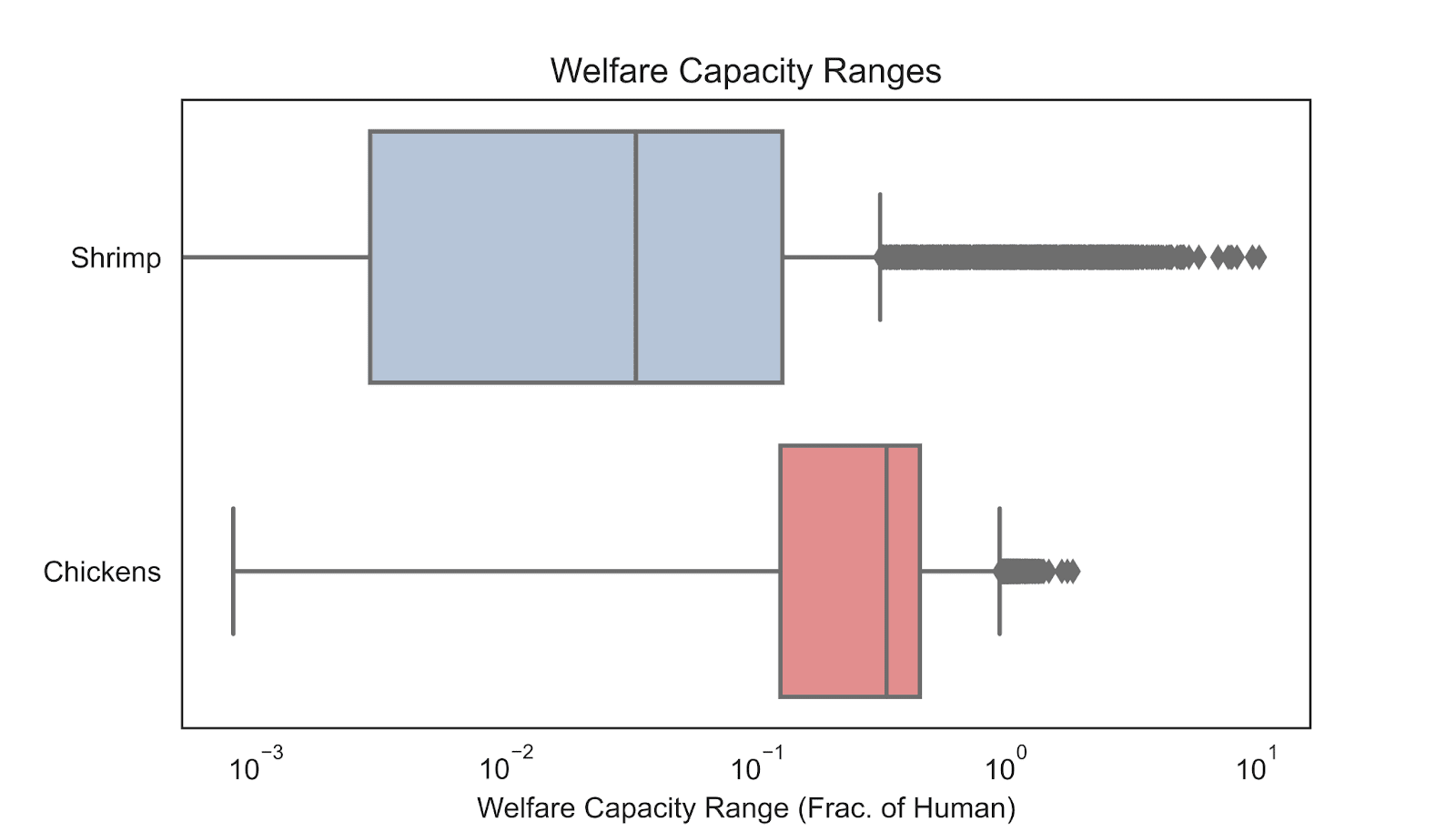
To categorize the different types of pain experienced by a given animal, I used the pain standards established by the Welfare Footprint Project (WFP). My medium-confidence guess is that when suffocating or freezing, shrimp are mostly experiencing discomfort that would meet WFP’s “disabling pain” standard:
Disabling Pain: Pain at this level takes priority over most bids for behavioral execution and prevents all forms of enjoyment or positive welfare. Pain is continuously distressing. Individuals affected by harms in this category often change their activity levels drastically (the degree of disruption in the ability of an organism to function optimally should not be confused with the overt expression of pain behaviors, which is less likely in prey species). Inattention and unresponsiveness to milder forms of pain or other ongoing stimuli and surroundings is likely to be observed. Relief often requires higher drug dosages or more powerful drugs. The term Disabling refers to the disability caused by ‘pain’, not to any structural disability.
I think it is likely that some dying shrimp meet WFP’s “excruciating pain” standard, particularly those that are crushed under other shrimp or under ice. However, this level is so extreme that I expect it does not make up the bulk of suffering experienced during slaughter. It is also possible that a fraction of shrimp are successfully rendered unconscious quickly under current methods by coming into contact with ice, reducing the average level of pain to WFP’s “hurtful pain” level. To weight pain at these different levels, I followed the same approach as the recent Rethink Priorities report “Cost-Effectiveness of Historical Farmed Animal Welfare Ballot Initiatives,” authored by Laura Duffy, which weights an hour of hurtful pain as equivalent to 0.15 hours of disabling pain and an hour of excruciating pain as equivalent to 5 hours of disabling pain. Because I think the average pain level is most likely slightly above the “disabling’ level, with significant uncertainty, I estimated the average pain intensity weight for shrimp during slaughter as a gamma distribution with ɑ = 1.5 and β = 1 (clipped at a range of 0.15 to 5). This distribution gives an average pain intensity weight of 1.5x the disabling pain level, and is shown in Figure 2.
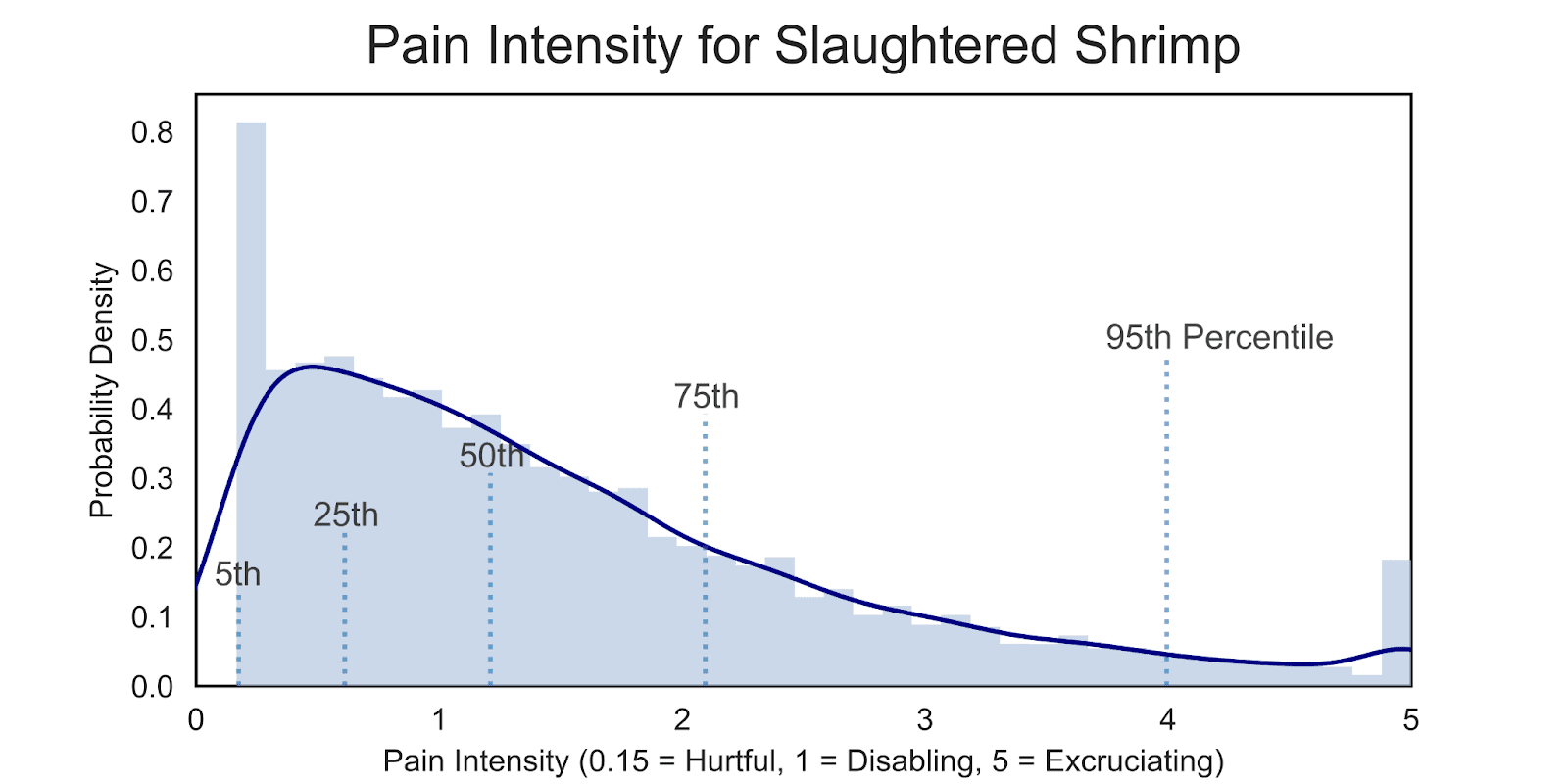
The duration of suffering during slaughter is currently an area of significant uncertainty for me. Based on SWP’s “minutes / hours” statement, I estimated the distribution of suffering during slaughter as a lognormal distribution with a mean of 20 minutes and a 97.5th percentile estimate of 3 hours. This distribution is shown in Figure 3.
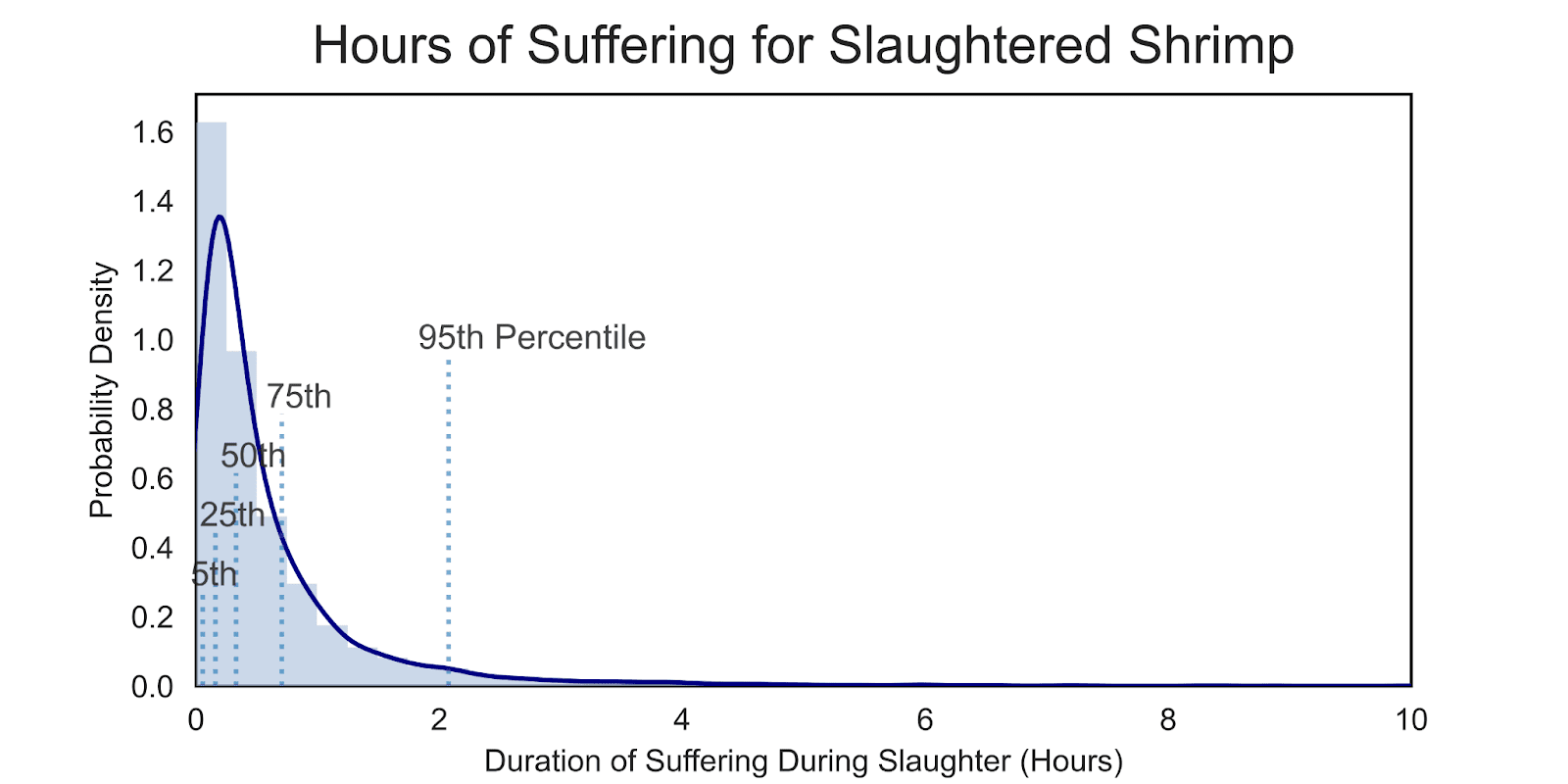
Ideally, stunning would remove 100% of the pain associated with slaughter. However, as indicated in SWP’s summary, there is some disagreement among experts as to the effectiveness of electric stunning in rendering shrimp unconscious. My educated guess, based on the conflicting scientific evidence and the LSE report’s “medium confidence” estimate of electric stunning’s effectiveness, is that electric stunning has about a 2 in 3 chance of rendering shrimp unconscious, for a probability of 0.667.
The number of shrimp stunned per dollar was estimated based on SWP’s “back-of-the-envelope calculation” included in the Manifund description. This information is provided in Table 2. I translated SWP’s calculations into a probability distribution by assuming that the number of shrimp helped per dollar was normally distributed with mean equal to SWP’s estimate (14796) and standard deviation equal to the average difference between the number of shrimp helped per dollar at each producer and the total average (7708). The lower end of this range might represent SWP encountering unexpected challenges that prevent the stunners being fully successfully utilized, while the upper end of this range might represent the stunners being successfully used (and having counterfactual impact) for more than the three years baselined in SWP’s analysis. This distribution is shown in Figure 4.
Table 2. Estimate of Shrimp Helped Per Dollar (from SWP Project Description)
SIGNED
TOTAL
Metric Mer Seafood
Seajoy - Cooke
Total production p.a. (MT) 2,300
12,500
14,800
Total production p.a. (g) 2,300,000,000
12,500,000,000
14,800,000,000
Number of grams per shrimp (1) 14
14
14
Total production p.a. (MT) 164,285,714
892,857,143
1,057,142,857
% Committed to be stunned (2) 75%
50%
54%
Total number of shrimps stunned p.a. 123,214,286
446,428,571
569,642,857
Number of years brought forward (3) 3
3
3
Number of shrimps helped 369,642,857
1,339,285,714
1,708,928,571
Cost-effectiveness Cost (€) 50,000
55,000
105,000
FX US/EUR 1.10
1.10
1.10
Cost ($) 55,000.0
60,500.0
115,500.0
Shrimps helped / $ / annum 2,240
7,379
4,932
Shrimps helped / $ 6,721
22,137
14,796
Notes:
1. Assumption of size approximately 70 shrimps / kg
2. As per signed commitment
3. Assumes we counterfactually bring forward adoption by such many years
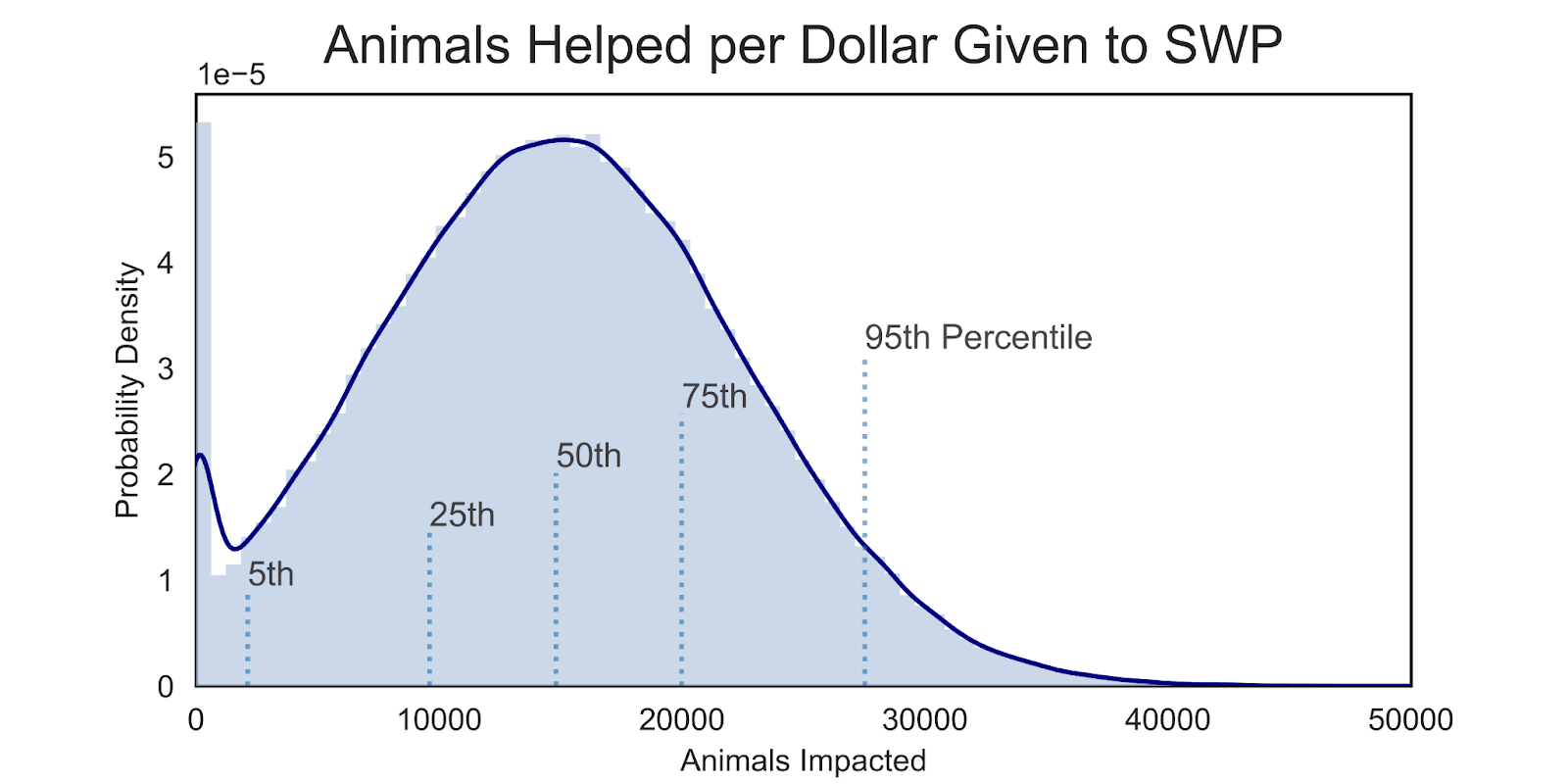
My estimate of hours of disabling pain averted per dollar spent on corporate chicken welfare campaigns comes from Duffy (2023). The report estimates that corporate welfare campaigns have averted 1.7 years of disabling-equivalent pain per dollar spent, with a 95% confidence interval from 0.23 to 5.0.[1] I approximated this result as a gamma distribution with ɑ = 1.7 and β = 1, multiplied by (24*365) to convert to hours per dollar. This distribution is shown in Figure 5.
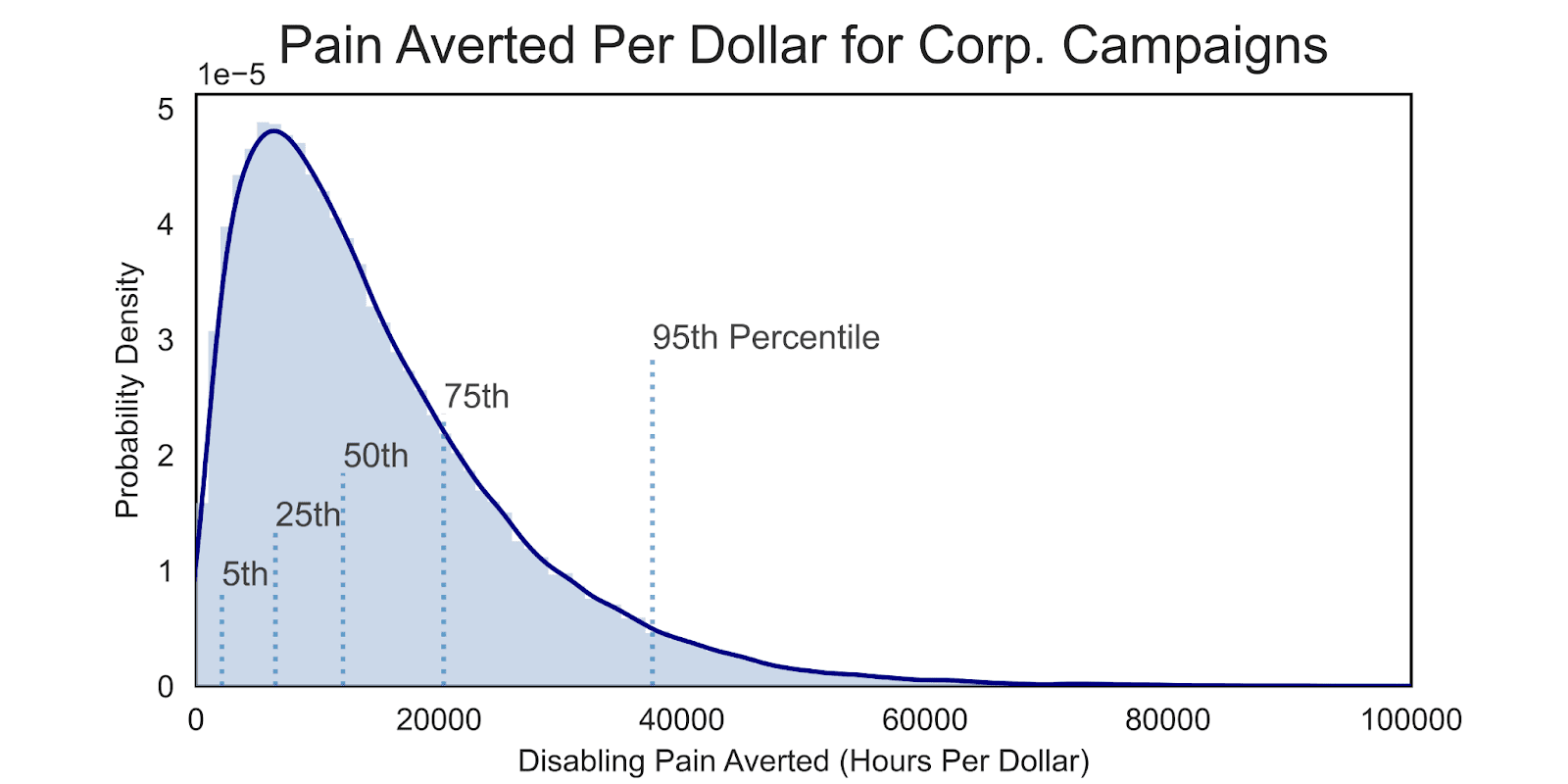
Using these inputs, I computed distributions for welfare-range-weighted hours of disabling- equivalent pain averted per dollar spent on shrimp stunners and on corporate welfare campaigns for chickens. These results are shown in Figure 6. I also repeated the calculation with the welfare capacity range of shrimp capped at 0.1x that of humans, with results shown in Figure 7. Summary statistics are provided in Table 3.
Table 3. Results Summary Statistics
Intervention | Number of Welfare-Range-Weighted Hours of Disabling-Equivalent Pain Averted per Dollar Spent | |||||
|---|---|---|---|---|---|---|
Mean | Percentiles | |||||
5th | 25th | 50th | 75th | 95th | ||
| Shrimp Stunners | 1660 | 0.0002 | 4.51 | 61.6 | 461 | 5940 |
| Shrimp Stunners (Shrimp Welfare Range Capped at 0.1) | 373 | 0.0002 | 4.39 | 51.3 | 277 | 1735 |
| Corporate Hen Welfare Campaigns | 4860 | 22.0 | 1010 | 2910 | 6580 | 16400 |
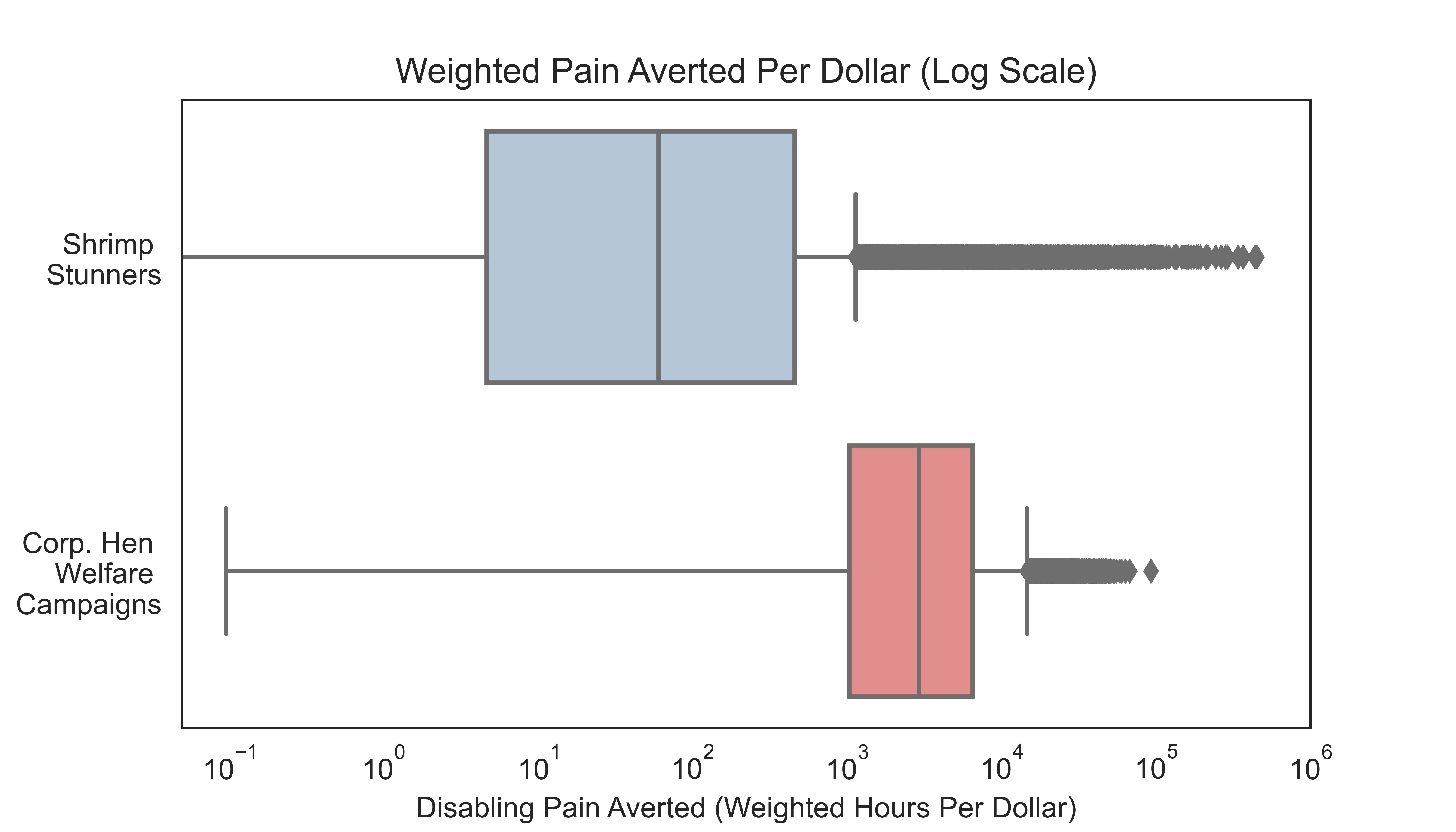
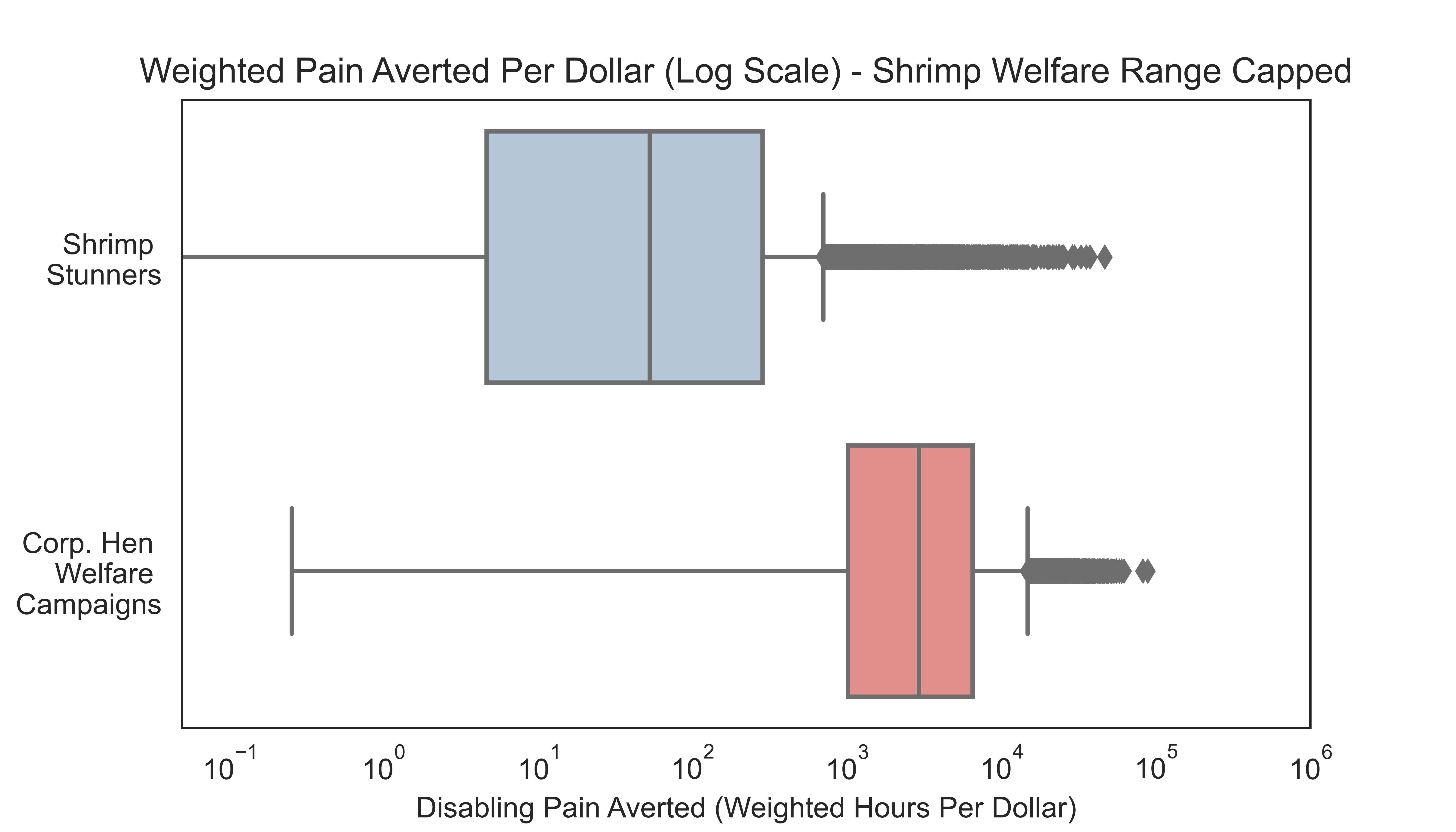
Discussion
A theme throughout this analysis is the high degree of uncertainty in estimating the cost-effectiveness of humane shrimp slaughter. Many key parameters are based on subjective guesses, and there is a large amount that remains unknown. There are reasons to think that the cost-effectiveness estimates provided here for both SWP and corporate hen welfare campaigns could be higher than the true values; some values in the SWP analysis are based on data provided by the organization itself and the data on corporate campaign effectiveness is backward-looking. And one could reasonably argue against certain assumptions underlying the RP Moral Weights Project’s results, or against the implicit assumption within this analysis that harms across many neurologically simpler shrimp can, in aggregate, outweigh harms to fewer, more neurologically complex chickens.
With all that said, I do think this analysis provides some useful information. It indicates that:
- The expected cost-effectiveness distribution for electric shrimp stunning likely has overlap with that of corporate hen welfare campaigns
- The cost-effectiveness of electric shrimp stunning is more likely to be lower than that of corporate hen welfare campaigns than it is to be higher
- Shrimp stunning is a very heavy-tailed intervention. The mean cost-effectiveness of stunning is significantly influenced by a few extreme cases, which mostly represent instances in which the undiluted experience model of welfare turns out to be correct
Based on this information, it seems reasonable to conclude that this project should not be dismissed out of hand. While these results are suggestive that shrimp stunning is a less cost-effective intervention than corporate hen welfare campaigns, they cannot clearly establish which is better —an important result given that corporate campaigns are the “gold standard” EA animal welfare intervention.
In light of item three, one might reasonably argue that this intervention constitutes something of a Pascal’s mugging, in that a large share of the impact is driven by a small number of relatively unlikely extreme cases. Most but not all the impact is driven by these cases—capping shrimp’s welfare range at 0.1x that of a human drops the mean cost effectiveness by about a factor of 5. This is still much greater than the 5th-percentile estimate of corporate hen welfare campaigns’ cost-effectiveness, but is low enough as to appear relatively uncompetitive with corporate campaigns in expectation. Potential donors should think carefully about their risk tolerance, credence in the undiluted experience model of welfare, and willingness to make hits-based bets when considering this initiative.
One last item to mention is the future potential of shrimp stunning. While this CEA has focused on the more quantifiable short-term impacts of SWP’s proposed intervention, it is possible that piloting stunners today could substantially improve the likelihood of long-run mass adoption. To me, this seems like one of the strongest arguments in favor of this project. Corporate hen welfare campaigns may not remain cost-effective forever (as fewer hens remain in conventional systems), and aquaculture is a rapidly growing industry worldwide. I think it makes sense to include some more speculative bets in the EA animal welfare portfolio, and shrimp stunning appears to be a possibly cost-competitive bet to make. In tandem with continued investment in fundamental welfare biology research, moderate-scale investments in shrimp stunning could enable learning by doing as part of the long-run development of effective interventions to improve conditions in aquaculture.
Thank you to Aaron Bergman for providing comments on a draft version of this post.

First and foremost, I want to express my deep gratitude to @MHR, @MarcusAbramovitch and @Aaron Bergman for kickstarting this discussion in the EA Forum. As mentioned in the post, this is currently SWP’s most cost-effective programme and one that we are very keen to continue to scale in the coming few years. To achieve that, we expect to rely on the support of our existing donors but also on that of the EA Community at large.
Second, we couldn’t have asked for a better way to get the conversation started than for a third party to look at our programme in such depth and to put it to the community for consideration in an impartial way.
Finally, I want it to be clear that my comments should not be interpreted as a negative reaction to the post but quite the opposite. It would have been nearly impossible to do a better job at portraying and evaluating our programme without further ‘insider intel’ which I hope to provide a bit of here.
Thank you!
In the coming days, we might have some more feedback on the specific assumptions made in the post but I wanted to make some clarifications as early as possible:
FUNDING
OVERALL PROGRAMME
COST-EFFECTIVENESS ESTIMATES
Thanks Andrés, this is great information! I've added a summary and link to your comment at the top of the post.
These ratios seem somewhat conservative to me, i.e. I think we can make a case for disabling pain being much more than 1/0.15=~6.67 times worse than hurtful pain, and excruciating pain being much more than 5 times worse than disabling pain. I view this as partly a question of how animals actually respond (e.g. what kinds of tradeoffs they would make, or we would make in their place), and partly a normative/moral question, so subject to normative/moral uncertainty. Ren Springlea underwent some intense pain and estimated how bad the different WFP intensity levels were. Here's the table reproduced from their post after undergoing these experiences:
According to Ren's estimates, disabling pain was around 50x worse than hurtful pain, and excruciating pain was possibly infinitely worse than disabling pain.
Both chicken (hen and broiler) welfare reforms and shrimp stunning reduce excruciating pain in expectation,[1] but I'd expect shrimp stunning to do so more cost-effectively, if as many shrimp experience excruciating pain during slaughter as you assumed (ideally, we could gather more evidence on that, too).
On the other hand, there might be more cost-effective ways to reduce excruciating pain for chickens by focusing on slaughter instead of more general asks, too. Or, we should also look at shrimp stunning as part of the overall portfolio of work to help shrimp, although SWP is seeking separate funding for it.
According to Welfare Footprint Project for chicken welfare reforms.
TL;DR: I think donations to SWP may be in the conversation for the single most cost-effective opportunity available to humanity.
Just saw this comment by chance when doing some of my usual late-night reading about shrimp welfare, and thought I'd reply because somebody mentioned me on the internet!
I've thought about this specific question (weightings between the different pain categories) at length, and there's quite a bit of uncertainty as with any esoteric area of philosophy. I don't put that much weight on my own experience that Michael described (as these decisions are too important to rely on my own experiences). I know a few people are thinking about this, so I've seen what various people have written about this; a small amount of academic research; some informal surveys; and a fair amount of philosophy. I think that any discussion of this topic needs to acknowledge this uncertainty. I think in a couple of years, we'll be in a much more informed position about the trade-offs between pain categories, perhaps with the exception of excruciating pain.
I've also given shrimp welfare and shrimp stunning some detailed thought (and my colleagues will know just how critical and conservative I am when conducting research!).
That said:
Overall, given this thinking as well as my own detailed research into various aspects of the animal advocacy movement, I think donations to SWP may be in the conversation for the single most cost-effective opportunity available to humanity today, possibly ever (subject to usual moral uncertainty stuff around the big worldview questions, of course). Some healthy uncertainty around the pain weightings doesn't change that.
Also, might be worth saying that if anybody strongly disagrees with this claim, I'd be keen to collaborate on a cost-effectiveness analysis of SWP and some other highly cost-effective opportunity (especially outside of the animal space) to see where the cruxes are.
Something I think is worth mentioning, but that I didn’t get to in the main body of the post, is priors-based critiques of the RP moral weights. I think a lot of people find some of RP’s results (e.g that octopuses have a >5% chance of being able to realize more than 1. 4x the instantaneous welfare of a human) intuitively unreasonable, and might understandably question the overall methodology for producing these kinds of outcomes. RP has responded to these critiques, but I do share some of these concerns; I would be skeptical of an argument for prioritizing animal welfare over interventions that help humans that depended heavily on specific values in the MWP results. However, I am less concerned about these critiques when applied to this specific analysis, since this case is just comparing two animal welfare interventions. Critiques of the RP moral weights applied to this case would need to make an argument for why the relative weights of chicken and shrimp are wrong, not the absolute weights. I think concern about the undiluted experience model is the most salient of these critiques, which is why it was the primary critique discussed in the post.
Of course, one still needs to make the case for why it’s worth caring about animal welfare at all. But I think that case can be made without appealing to the specifics of the MWP results, and is outside the scope of this post regardless.
And that goes in both directions: some find it intuitively unreasonable to think that humans can realise far more welfare than some other animals. Additionally, the undiluted experience model seems pretty intuitive to many.
I would hope that in a community committed to impartiality, one need not have to make the case for why it’s worth caring about the welfare of beings that happen not to be members of our species, so it is totally fine not to include that in your post.
I think EA's cause prioritization would look very different if it genuinely were a "community committed to impartiality" regarding species. Under impartiality, both of these interventions are on the order of 1000x as cost-effective as GiveWell top charities.[1] (One could avoid this conclusion by believing pleasure/pain only account for on the order of 0.1% of welfare, but this is a deeply unusual view and is empirically dubious.[2]) Open Phil (OP) has recognized this since 2016.[3]
However, to this day, OP has only allocated 17% of its annual neartermist funding to animal welfare.[4] If OP really believes animal welfare is ~1000x as cost-effective as GiveWell top charities, it's difficult to understand how this allocation of funding could possibly be morally justified. Yes, many caveats could be made:
Why doesn't OP allocate a majority of neartermist funding to animal welfare? I don't know. My guess is that key decisionmakers aren't "committed to impartiality" regarding species. Holden Karnofsky has said as much: "My own reflections and reasoning about philosophy of mind have, so far, seemed to indicate against the idea that e.g. chickens merit moral concern."[6]
(Meme by me)
So, what to do? For one, it would be extremely helpful for OP to clarify their views on the questions relevant to animal welfare (how much of welfare is explained by hedonism, should one be impartial regarding species), what the cruxes are that would change their minds regarding cause prioritization, and the counterpoints which explain why they haven't changed their minds. (I'll be publishing a post within the next few months with the above arguments.)
I wish you were right that EA is a "community committed to impartiality" regarding species. However, empirically, it seems that's not the case.
Vasco Grilo (2023). "Prioritising animal welfare over global health and development?" https://forum.effectivealtruism.org/posts/vBcT7i7AkNJ6u9BcQ/prioritising-animal-welfare-over-global-health-and
Severe pain, such as cluster headaches, is associated with a greatly increased suicidality. Lee et al (2019). "Increased suicidality in patients with cluster headache". https://pubmed.ncbi.nlm.nih.gov/31018651/
"If one values humans 10-100x as much, this still implies that corporate campaigns are a far better use of funds (100-1,000x)." Holden Karnofsky (2017). "Worldview Diversification". https://www.openphilanthropy.org/research/worldview-diversification/
Ariel Simnegar (2023). "Open Phil Grants Analysis". https://github.com/ariel-simnegar/open-phil-grants-analysis/blob/main/open_phil_grants_analysis.ipynb
Open Philanthropy. "Rethink Priorities — Moral Patienthood and Moral Weight Research". https://www.openphilanthropy.org/grants/rethink-priorities-moral-patienthood-and-moral-weight-research/
Holden Karnofsky (2017). "Radical Empathy". https://www.openphilanthropy.org/research/radical-empathy/
This is interesting ! I had the same interrogation, their position doesn't seem that coherent.
Maybe you should to a post with this question, that would get noticed by someone at Open Phil and maybe get answered ?
Agreed. I'm planning on writing up a post about it, but I'm very busy and I'd like the post to be extremely rigorous and address all possible objections, so it probably won't be published for a month or two.
Thanks so much for this post. Very impressive how quickly you put this together.
I think your analysis is a very helpful take on how cost-effective it might be for advocates to purchase shrimp stunners for industry, and how this might compare to estimates of the cost-effectiveness of historical corporate hen welfare campaigns. Very useful to try and make different interventions comparable for interested stakeholders.
That said, I think your quantitive analysis probably misses most of the expected value of the SWP’s shrimp stunning intervention. My guess is that the vast majority of the expected value of this opportunity lies in how much it might bring forward widespread adoption of shrimp stunning by industry, and not the easier-to-quantify short-term direct impacts of the stunners SWP purchases for industry.
I think you recognise this issue in the last paragraph. And I also fully appreciate that even a relatively shallow attempt at quantifying wide-spread industry adoption scenarios was probably beyond the amount of time you could dedicate to this post.
That said, I’m not sure this limitation comes through fully in your summary, even after you the updates you added to the top. My biggest concern is that your report might put off potential donors who might assume your assessment more comprehensively covers benefits than it does, and might not have time to fully engage with your methodology or reach the final paragraph.
If you agree with my assessment, share my concerns, and were open to making changes while fundraising is ongoing, my suggestions would be to be more explicit about the scope limitations of your analysis and how most of the expected value might not be quantified (either by amending the summary or adding an additional update at the top). When describing the factors that might drive donor decisions, I’d personally also add optimism/pessimism about the potential for this project to bring forward widespread adoption by industry, which I see as independent of the factors you’ve already listed.
If you don’t agree with my assessment about where expected value might come from (e.g. because you think donors purchasing stunners for industry might set a dangerous precedent that might in fact delay adoption), or just happen to be deeply uncertain, I think it would be great for you to articulate this more explicitly.
Hope you don’t mind me making these suggestions. Really great work again - thank you for putting the time and effort into it.
Thanks for your comment! I broadly agree with the point you’re making, and have amended the summary to capture it. Let me know if you think the updated wording addresses your concern.
I did ponder trying to quantify the potential impacts of catalyzing industry-wide change as a result of this pilot, and I just want to lay out a little bit of why I think that’s so hard. It’s very tempting to compute a massive EV for this by doing a calculation like (small chance that this brings industry-wide adoption forward n years) * (400 billion shrimp farmed/year) = giant number. But I think that’s probably a bad way to look at it. I think the better way to think of it is that industry-wide adoption would take a successful pilot plus other forms of activism like corporate campaigns, ballot initiatives, or legislative lobbying. So the pilot alone isn’t necessarily bringing forward broader adoption, but rather creating new potentially cost-effective opportunities for donations. The exact EV would therefore depend on questions like the relative cost-effectiveness of those new donation opportunities compared to the existing animal welfare portfolio, and on how funding constrained the animal welfare space is expected to be over the next several years.
None of this is to say that I disagree with your point, just that I’m quite uncertain about the indirect cost effectiveness and would struggle to find a way to easily model it.
I think the edits you made to the summary work very well in making it clear what the quantitative analysis does and doesn't cover! Thank you for taking on board my comments so promptly.
Fully agree with your points on the difficulty of quantifying the indirect benefits, and also how/where those benefits should be attributed.
I think the challenge is that excluding indirect benefits from a quantitative analysis effectively assigns them a zero value. That is ok when indirect benefits are most likely only a small fraction of the direct benefits. But it becomes problematic when the indirect benefits could plausibly be several times (or orders of magnitude) larger than the direct ones and relevant to decision-making.
If judgements about the size of the indirect benefits might be important, think it is valuable to make the exclusions clear - as you've now done!
Thanks again for the time you put into the piece, and the clear write-up / reasoning transparency!
Thanks very much for this write-up MHR! We’ve recently published a “two-year update” post on the Forum, and wanted to reflect on some considerations we think most likely affect the Cost-Effectiveness of this project. Rather than including the below in that post, we thought it made sense to continue the discussion that had already started here.
MHR, thanks for the CEA. I just want to flag that I wrote that quoted part in the Manifund proposal, not Andres. I wrote it off of stuff that Andres sent to me but all mistakes are my own, not his. I'm going to encourage Andres to leave a comment here as well to give comments on the CEA.
Thanks for the clarification and encouragement ;)
Thanks for the correction! I've updated that section.
I left a comment on RP's post on welfare ranges here that's relevant.
Thanks! This is a very interesting thought!
Rather than capping shrimp welfare ranges at 0.1 (relative to humans), I would just exclude the undiluted experience model or cap welfare ranges (for both chickens and shrimp) at around 1, or report welfare range model-conditional estimates, because I think the equality-based model is not implausible, and probably many potential donors would give it substantial weight.
If you're taking means, you run into the two envelopes problem, and the undiluted experience model (and generally, the higher the variance in relative welfare ranges across models) is going to make it particularly bad. Typically, I think it’s only reasonable to treat the human welfare range as constant across models to normalize by and take expected values relative to based on agent-relative reasons, because we could otherwise consider the chicken or shrimp or fruit fly welfare range constant (or use some other scales, possibly multiple scales and moral uncertainty between them and an approach other than to maximize expected choiceworthiness, like a moral parliament), and you could end up with very different results under each.
In general, I'd want to report the cost-effectiveness of each intervention separately conditional on each welfare range model, because this doesn’t commit us to any specific way to identify units between the models (intertheoretic comparisons), or any specific approach to moral uncertainty or even specific probabilities to each model (and it's also a sensitivity analysis with respect to the welfare range model).
I'm also working on an article on this topic, but for some prior writing, see:
Thanks for your comment! I agree that there are plenty of options that would be useful other than using the raw welfare ranges or using the welfare ranges with a cap on shrimp at 0.1x humans' level. Here are the results with a cap on both shrimp's and chickens' welfare ranges at 1x humans':
Breaking out the cost-effectiveness results conditional on each welfare range model (or conditional on including/excluding the undiluted experience model) would be fantastic, but is probably outside the scope of what I have time to do.
I don't really understand your middle paragraph. Can you elaborate on what you mean by "agent-relative reasons?" I do understand the issue whereby which welfare range is taken to be constant can drive the outcome of an EV calculation. But I *think* that only ends up changing the results if your unit for welfare range is based one of the animals in the comparison? I think I'd get identical conclusions if I took fruit flies' welfare range to be the constant instead of humans', it would only change if I used chickens' or shrimp's as the constant. And I'm not trying to take EVs across multiple moral systems, I'm holding the moral system constant and taking EVs across different estimates of chickens' and shrimp's capacities for realizing welfare, which seems like it avoids some further pitfalls.
Thanks for doing and sharing these calculations!
If you used fruit flies (or other very small-brained animals) as having constant welfare range and included the neuron count model as a possibility, then the neuron count model would skew the expected values towards favouring chickens. This post illustrates this, although the model assumptions are different (conscious subsystems is an empirical/descriptive hypothesis about the number of moral patients conditional on each theory of consciousness and welfare, not a model or theory of consciousness and welfare per moral patient): https://forum.effectivealtruism.org/posts/vbhoFsyQmrntru6Kw/do-brains-contain-many-conscious-subsystems-if-so-should-we
By agent-relative reasons, I just mean each agent could have some reasons to fix their own welfare range without similar reasons to fix others' welfare ranges. Like maybe you just do ethics by projecting and extrapolating how you value your own experiences, which you assume to be fixed in value.
I think different theories of welfare (including different theories of hedonistic welfare), captured by the different models for welfare ranges, are effectively different normative/moral theories. So, if you do take expected values across them, you are taking expected values across different normative/moral stances.
Thanks! I appreciate the response